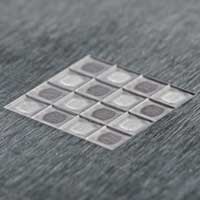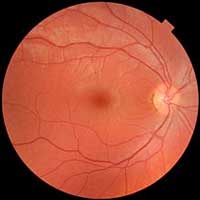 A team of researchers has made substantial progress in an effort to create a new type of molecular data storage system.
A team of researchers has made substantial progress in an effort to create a new type of molecular data storage system.
Tuesday, February 4, 2020
Researchers report progress on molecular data storage system
 A team of researchers has made substantial progress in an effort to create a new type of molecular data storage system.
A team of researchers has made substantial progress in an effort to create a new type of molecular data storage system.
Lasers etch a 'perfect' solar energy absorber
 Researchers use powerful femto-second laser pulses to etch metal surfaces with nanoscale structures that selectively absorb light only at the solar wavelengths, but not elsewhere.
Researchers use powerful femto-second laser pulses to etch metal surfaces with nanoscale structures that selectively absorb light only at the solar wavelengths, but not elsewhere.
Laser-engraved metal to reduce environmental impact
 Anti-fouling, hydrophobic metal or plastic surfaces that imitate shark skins, engraved by a new laser technology, could soon replace the toxic varnishes used in ship coatings to stop algae or barnacles sticking to hulls - reducing maintenance costs, fuel bills and CO2 emissions.
Anti-fouling, hydrophobic metal or plastic surfaces that imitate shark skins, engraved by a new laser technology, could soon replace the toxic varnishes used in ship coatings to stop algae or barnacles sticking to hulls - reducing maintenance costs, fuel bills and CO2 emissions.
Vibrations on a chip feel a magnetic field
 Physicists have made mechanical vibrations on a chip behave as if they were electrical currents flowing in a magnetic field.
Physicists have made mechanical vibrations on a chip behave as if they were electrical currents flowing in a magnetic field.
Retina-inspired carbon nitride-based photonic synapses for selective detection of UV light
 Scientists have developed photo-sensitive artificial nerves that emulated functions of a retina by using 2-dimensional carbon nitride nanodot materials.
Scientists have developed photo-sensitive artificial nerves that emulated functions of a retina by using 2-dimensional carbon nitride nanodot materials.
New funding for project to develop nanodevices against epilepsy and Parkinson's
 Novel nanotechnologies could be used as brain implants, modulating the activity of nerve cells electrochemically and treating neurological diseases.
Novel nanotechnologies could be used as brain implants, modulating the activity of nerve cells electrochemically and treating neurological diseases.
Sweet nanoparticles trick kidney
 Researchers engineer nanoparticles with sugar molecules to prevent side effect in cancer therapy.
Researchers engineer nanoparticles with sugar molecules to prevent side effect in cancer therapy.
Single atom as measuring probe uses quantum information for the first time
 Researchers have succeeded for the first time in using a single caesium atom as a sensor for ultracold temperatures.
Researchers have succeeded for the first time in using a single caesium atom as a sensor for ultracold temperatures.
Thinning down Weyl semimetals provides a new twist to spintronics
 Using a material's spin property to carry current opens up the possibilities to transfer data at much higher speed and achieves better energy efficiency than traditional devices that rely on electrical charges. However, this requires a material that can generate long-lived pure spin current with high efficiency.
Using a material's spin property to carry current opens up the possibilities to transfer data at much higher speed and achieves better energy efficiency than traditional devices that rely on electrical charges. However, this requires a material that can generate long-lived pure spin current with high efficiency.
Acoustically driven microrobot outshines natural microswimmers
 Researchers have designed and fabricated an untethered microrobot that can slip along either a flat or curved surface in a liquid when exposed to ultrasound waves. Its propulsion force is two to three orders of magnitude stronger than the propulsion force of natural microorganisms such as bacteria or algae.
Researchers have designed and fabricated an untethered microrobot that can slip along either a flat or curved surface in a liquid when exposed to ultrasound waves. Its propulsion force is two to three orders of magnitude stronger than the propulsion force of natural microorganisms such as bacteria or algae.
Finding the source of chemical reactions
 Scientists have demonstrated a way to experimentally detect the most hidden aspect of all chemical reactions - the extremely short-lived transition state that occurs at their initiation. This pivotal discovery could become instrumental in gaining the ability to predict and externally control the outcomes of chemical processes.
Scientists have demonstrated a way to experimentally detect the most hidden aspect of all chemical reactions - the extremely short-lived transition state that occurs at their initiation. This pivotal discovery could become instrumental in gaining the ability to predict and externally control the outcomes of chemical processes.
Subscribe to:
Comments (Atom)
